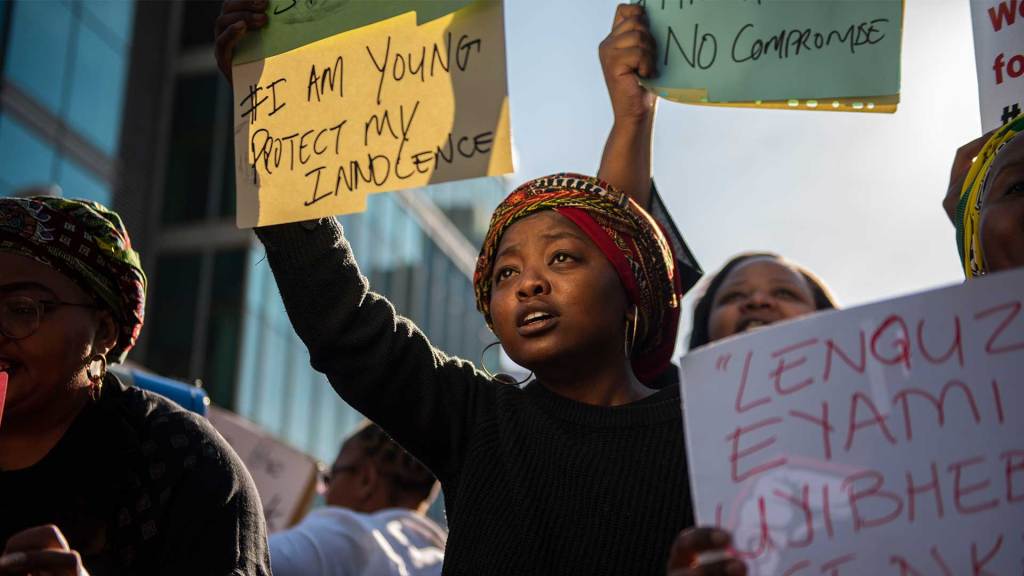 Getty
GettyMandisa Khanyile spent the afternoon of #TheTotalShutdown women’s march in Pretoria, South Africa, extinguishing one crisis after another. The permits she’d arranged for the rally in the city’s center were now being challenged. Human rights organizations needed to be on standby in case participants were beaten or kidnapped. The country’s president, Cyril Ramaphosa, had promised to meet her and her co-organizers to receive their list of 24 demands—plans they hoped would, with his support, end the scourge of gender-based violence and femicide in their country—but, suddenly, he was nowhere to be found. Her phone buzzed incessantly with questions from the 50-plus WhatsApp groups simultaneously running sister marches across South Africa and in Botswana, Kenya, even Venezuela and Germany. She was exhausted.
But at one point, amid all the furious texting, she paused and looked up at the more than 40,000 women, girls, and gender-nonconforming people rallying around her. She was floored. “It was just rows and rows of bodies, filling up entire streets. Just a sea of women’s faces,” Khanyile recalled. “I cried my eyes out, because sometimes, you think people aren’t going to take you seriously. And these women really came; they showed up.”
Khanyile—and the thousands of women who marched with her across South Africa and around the world on August 1, 2018—made history that day, executing the largest coordinated protest by women to ever happen in South Africa. And their impact didn’t stop there: The very next day, Ramaphosa (who did eventually appear at the march, some six hours late) convened #TheTotalShutdown’s leaders, including Khanyile, to create something previously unimaginable for the country: a process to develop a national strategic plan and dedicated fund to end gender-based violence against women, girls, and gender-nonconforming people.
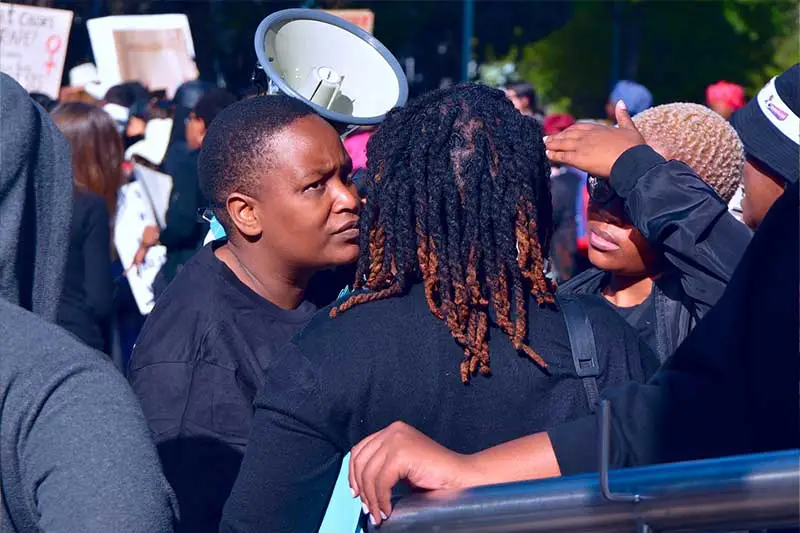 Katty Vandenberghe
Katty Vandenberghe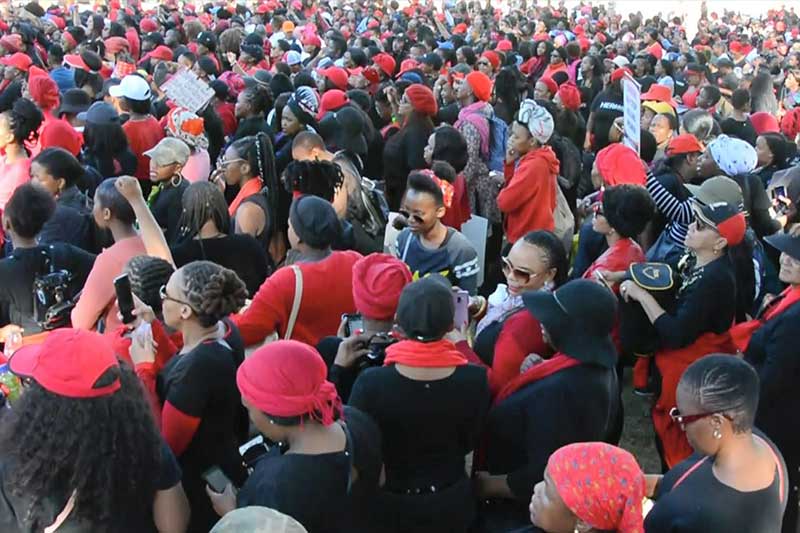 Katty Vandenberghe
Katty VandenbergheMandisa Khanyile (left) manages details for the more than 40,000 women, girls, and gender-nonconforming people who participated in #TheTotalShutdown women’s march in Pretoria, South Africa, on August 1, 2018. It was the largest coordinated protest by women to ever happen in the country.
In South Africa, these milestones were gratefully received but long overdue: For decades, the country has ranked as one of the most dangerous in the world for femicide and intimate partner abuse. It has been estimated that a woman is killed in South Africa every four hours, and at least half of them murdered by an intimate partner. The rate at which women are killed by intimate partners is also five times higher than the global average. Instances of rape rank among the highest in the world, with only one in 25 cases reported to the police.
“It’s not a good situation for us in South Africa—and it’s still an invisible issue,” said Candice Ludick, one of the organizers of the #TheTotalShutdown marches. “In many circles, women and children are still regarded as property, so to get people to see us as human beings is a first step that, in many cases, is not happening. As a country, we have a history of institutionalized and state-sanctioned violence, and our systems are still skewed in favor of perpetrators who take advantage of those perceived to be weaker than them.”
From this fear and frustration, #TheTotalShutdown movement was born online in early 2018. All summer, South African news stations had reported on an uptick of femicide across the country. One young woman, Karabo Mokoena, had been murdered by her ex-boyfriend in a particularly grisly manner, and his trial had received incessant, sensational media coverage. A dozen South African feminists started chatting in a Facebook group about the hypocrisy of a government that commemorated each August as “Women’s Month” but failed to protect them from the constant violence they faced all year. Talk quickly turned toward how they—the women of South Africa—could bring attention to the issue of gender-based violence by doing something offline and unignorable—something like a march.
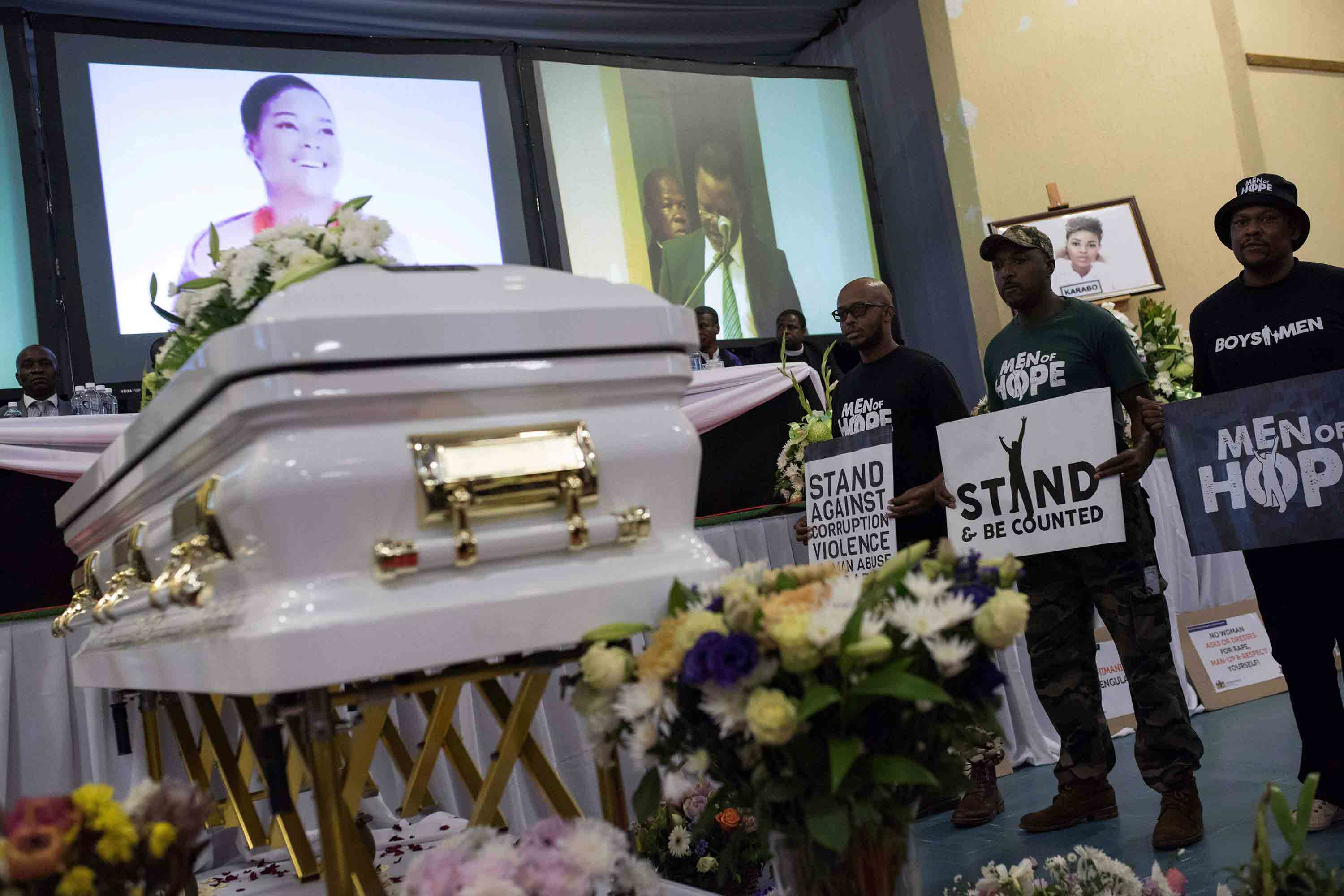 Getty
GettySupporters of Karabo Mokoena, who died in 2017 at the hands of her boyfriend, make a stance at her funeral in Johannesburg. She is one of many South African women who have lost their lives to gender-based violence. It was her death that gave birth to #TheTotalShutdown movement.
Word spread, and the tiny Facebook group’s membership exploded north of 100,000. A small steering committee began coordinating a march in Pretoria, South Africa’s administrative capital, for the first day of 2018’s “Women’s Month.” On Facebook, Twitter, and WhatsApp, they reached out to women in urban and rural areas across the country; when many said they couldn’t afford to travel to Pretoria, they helped them organize sister marches in their provinces. And all the while, the steering committee fine-tuned a list of 24 demands—24, to reflect the number of years since South Africa had become a democracy—they believed would make their country safer for women, girls, and gender-nonconforming people.
Sibongile Mthembu, a member of #TheTotalShutdown’s steering committee and a coordinator of the Pretoria march, said that in those early months, she and her co-organizers spent ample time studying their country’s previous social movements, including the 2016 Fees Must Fall student protests and especially the one they considered the most successful, the 1956 Women’s March. Then, an estimated 20,000 women and girls had marched to the administrative center of Pretoria to protest apartheid and the country’s internal pass system, designed to segregate the population by limiting mobility of Black citizens.
“Ours was not the first attempt to gather women and say, ‘Let’s do something about this problem,’ but we knew what we were doing was historical,” said Mthembu. “It shows you the history of South Africans to be women committed to different struggles at different periods.”
By the time #TheTotalShutdown march happened, in the same governmental plaza as the 1956 Women’s March, over 20 other marches had been coordinated alongside it—including ones in Cape Town and Durban that also attracted thousands. Online, the marches’ convenors asked men to support them by not spending money that day, and they reiterated their ultimate demand: that their government do more to protect them from violence.
The South African media didn’t miss the memo: All day, they aired footage and images of marchers dressed in red and black, waving signs that read “Femicide Must Fall” and “No Means No Every Time” and singing the resistance song “Wathint’ Abafazi, Wathinti’ Imbokodo” (“You Strike a Woman, You Strike a Rock”). They also aired women speaking candidly about their personal experiences with gender-based violence—some of the first times such stories had ever aired on national media.
Andy Kawa was one of #TheTotalShutdown supporters who marched in Pretoria because of her experience with gender-based violence. In 2010, she was abducted and gang-raped in Port Elizabeth but her attackers were never apprehended. In response, she wrote a book about her dispiriting experience with the country’s judicial system and led two marches to raise awareness about gender-based violence. She also cofounded the Kwanele-Enuf Foundation to help other survivors.
“#TheTotalShutdown march was very emotional for me,” she said. “Being part of all the people who were marching under one voice, knowing it was happening countrywide, and seeing the leaders talking about [gender-based violence] afterward—it was just something beyond my imagination.”
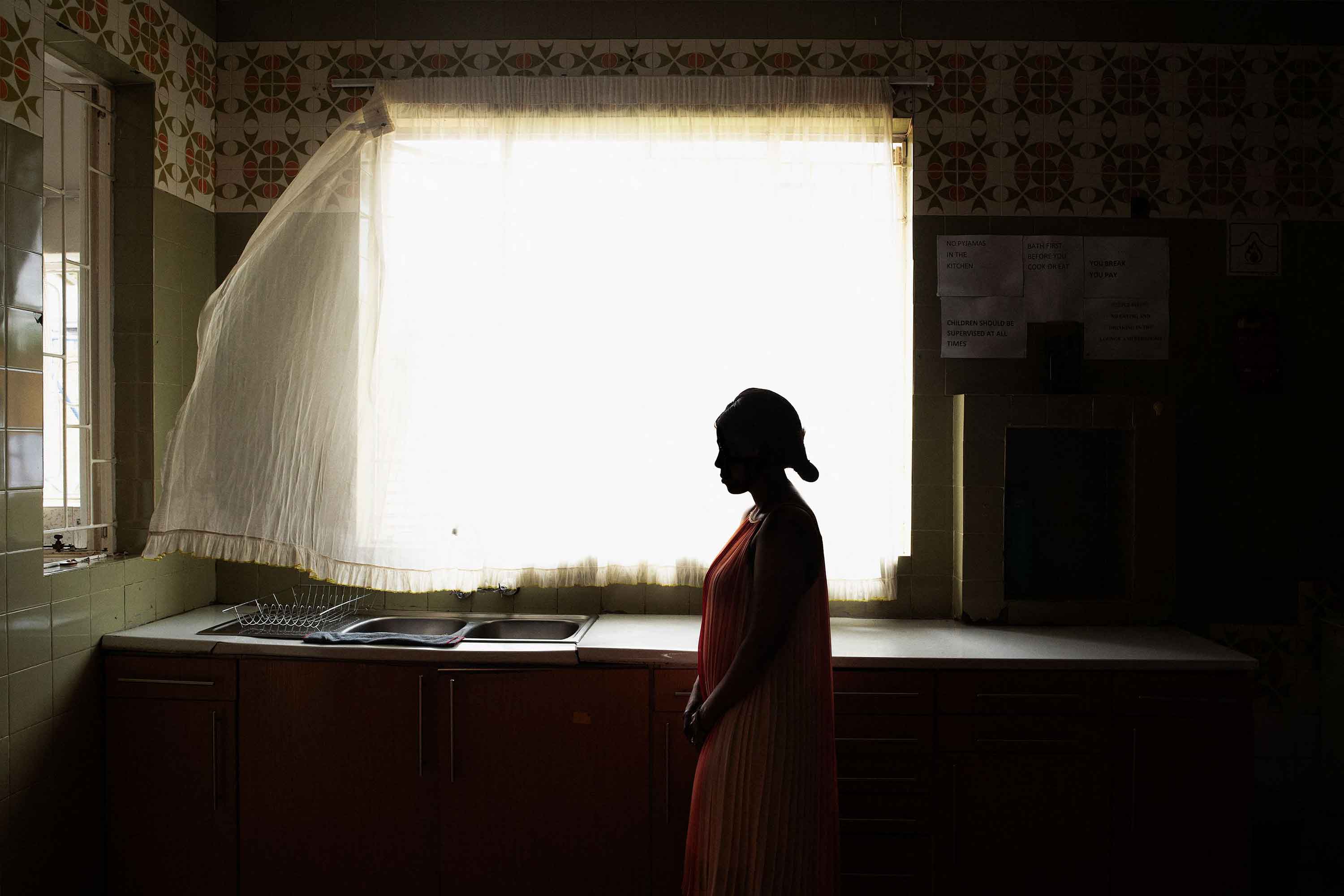 Getty
GettyA survivor of gender-based violence in her room at the Nisaa Center, a shelter for abused women, on the outskirts of Johannesburg. South Africa is one of the most dangerous places in the world for women with one of the highest rates for such violence.
For Kawa, the organizers, and many others, #TheTotalShutdown movement was cathartic, a space where they could share their experiences with abuse. Ahead of August 1, the organizers spread a hashtag campaign, #IWillMarchWithYou, on social media to invite survivors to tell their stories.
“I was molested by my pastor when I was six, so I said, ‘I will march with you because this is what happened to me,’” said Khanyile, who now works as director of the Ford-funded nonprofit Rise Up Against Gender Based Violence. “I didn’t have people in the church that cared enough to take this up as an issue.”
The night after the march, #TheTotalShutdown’s steering committee took a moment to celebrate their victory—some, like Mthembu, sleeping for the first time in days. Then, one by one, they were awoken at 6 a.m. by ringing phones; Ramaphosa had reviewed their demands and wanted to meet with them in three hours.
That convening with Ramaphosa led to the formation of an organizing group, comprised of members from the office of the presidency, civil society organizations, and #TheTotalShutdown’s organizers—collaborating for the first time to erase gender-based violence. Less than three months later, on November 1 and 2, Ramaphosa fulfilled the No. 1 demand of #TheTotalShutdown movement’s initial 24: He hosted South Africa’s first-ever presidential summit to end gender-based violence and femicide, recognizing it as a national crisis and committing to a national plan to end it.
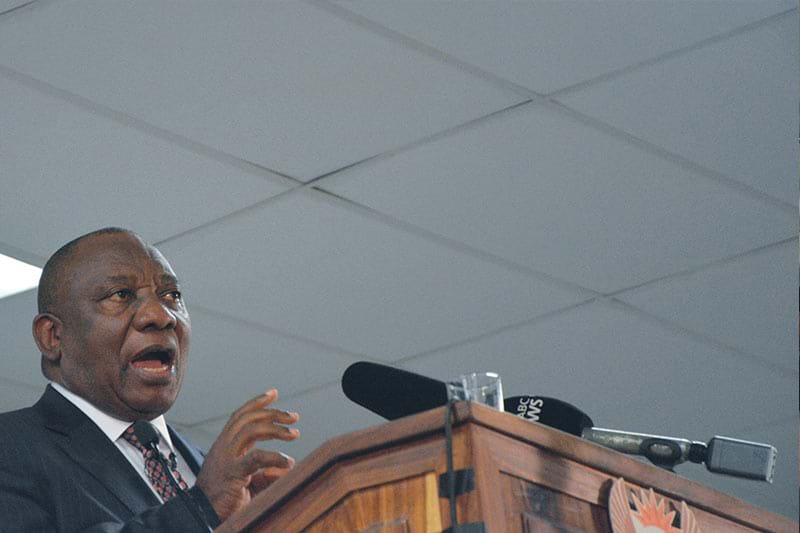 Katty Vandenberghe
Katty Vandenberghe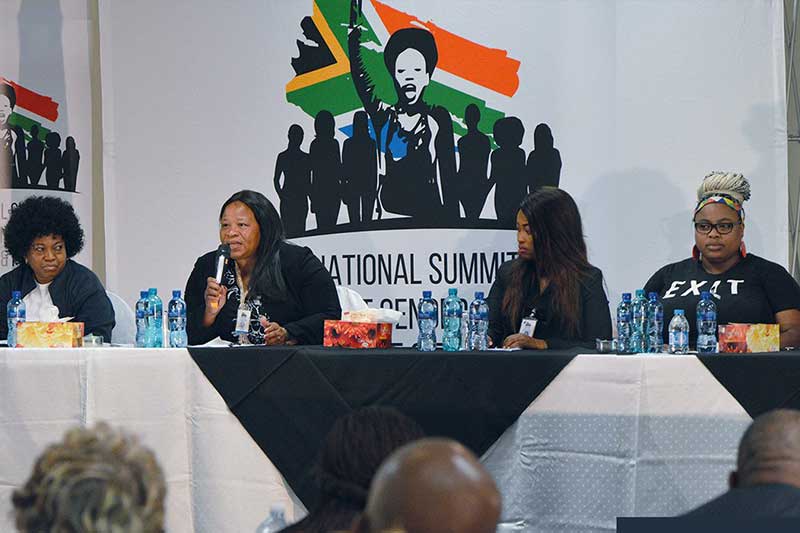 Katty Vandenberghe
Katty VandenberghePresident Cyril Ramaphosa (left) speaks at the National Summit Against Gender-Based Violence and Femicide in November 2018 alongside the grassroots feminist organizers who fought to bring the issue to his attention. In a momentous vow to end violence across the country, his administration pledged 1.6 billion rand (approximately $91 million) to a dedicated fund.
After the summit, a formal interim steering committee was established, with the goal of developing a national plan to end gender-based violence, emphasizing input from young people, LGBTQ+ communities, and women with disabilities. (Ford funded this committee.) Launched in April 2020, 18 months later, the National Strategic Plan on Gender-Based Violence and Femicide—the most comprehensive and inclusive governmental strategy ever proposed in South Africa—hewed closely to #TheTotalShutdown movement’s initial slate of ideas.
This steering committee’s ambitious blueprint to curb abuse, femicide, and the misogynistic culture of South Africa called for increased accountability and leadership, expansion of safety and protection services, financial empowerment, and more. It required police to undergo sensitization training to unlearn bias and default to believing survivors when they reported cases of rape or abuse. It proposed new economic opportunities for women so they wouldn’t remain financially dependent in abusive relationships. And it also outlined educational programs for children to help undo harmful, entrenched stereotypes about men and women, drawing on feminist principles and emphasizing collaboration between government, civil society, and philanthropy and the private sector.
It also supported the creation of a dedicated gender-based violence fund, financed by the South African treasury, the local and international private sector, and civil society organizations. This was another first for the country, and the pledge from Ramaphosa’s administration was momentous: The treasury vowed to contribute 1.6 billion rand (approximately $91 million), made up of reallocated funds from other government departments. The national plan and fund were celebrated by feminists and media—but #TheTotalShutdown’s organizers were cautiously optimistic.
“These were very promising developments for women and girls in South Africa, absolutely,” said Ludick, who is now the communications coordinator of End GBVF Collective, a collaborative of volunteers from government, civil society, and the private sector that Ford funds. “But then, there’s also the reality of how legislation works and how legislation gets passed in this country.”
Their hesitation, unfortunately, proved well-founded: Less than six months after the announcement, just as Ramaphosa was poised to sign both the plan and fund into law, COVID-19 swept South Africa. As the entire country went into lockdown, Ramaphosa’s administration took an unusual step: It banned the sale of alcohol nationwide, along with closing bars and clubs, in the hopes that this would prevent violence. This was partially successful: Crime rates dropped across the country, and trauma cases in South African hospitals decreased. However, with abusive men now unable to leave their homes to drink and socialize, they turned their anger onto the women and children in their households, and gender-based violence, femicide, and teenage pregnancy rose across the country.
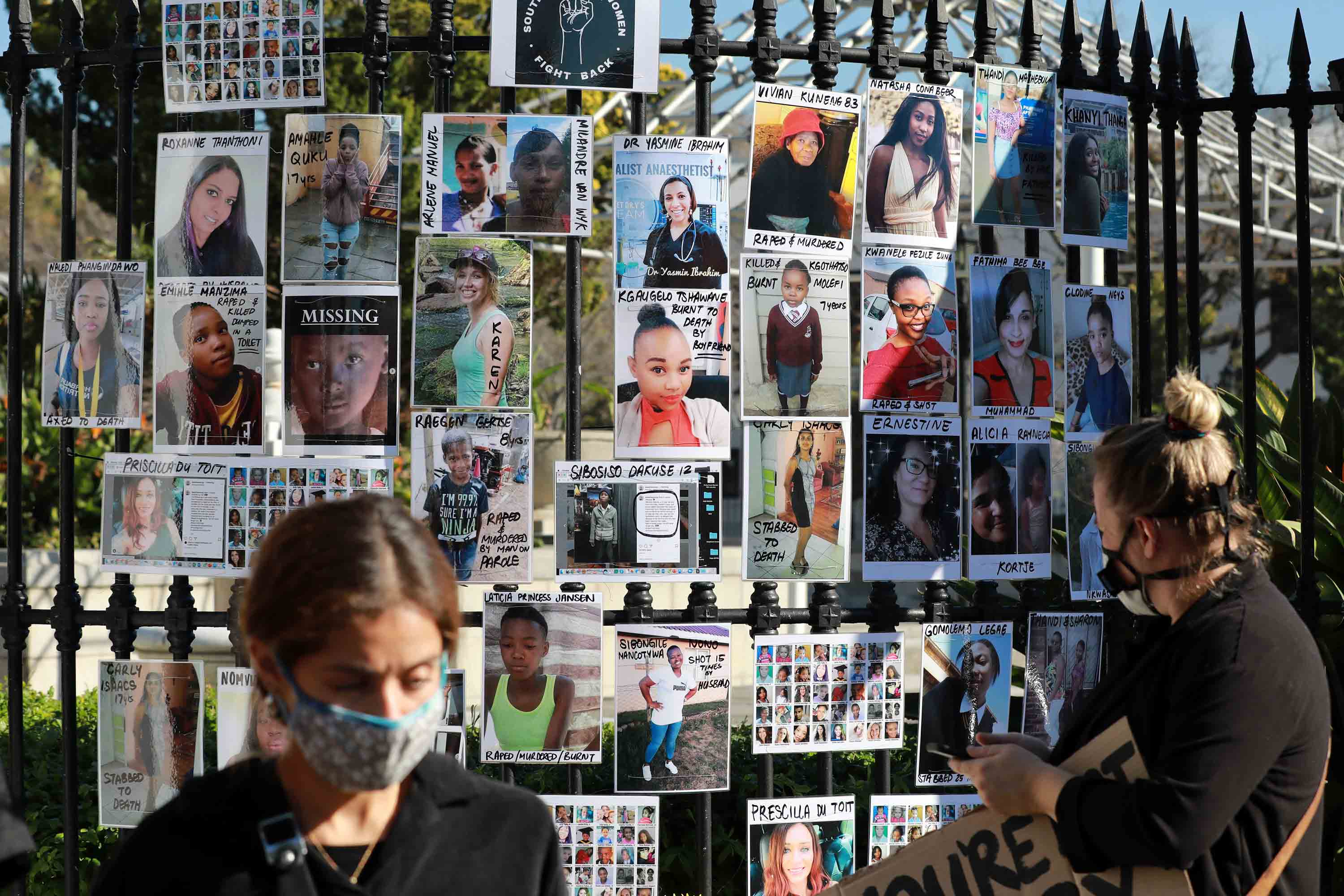 Getty
GettyIn South Africa, the rate at which women are killed by intimate partners is five times higher than the global average. When the country shut down as COVID-19 spread across the globe, crime rates dropped but gender-based violence rose, causing president Ramaphosa to call it the country’s “second pandemic.”
Seeing this worrying trend, Ramaphosa returned his attention to gender-based violence, calling it the country’s “second pandemic” and vowed to redouble his efforts. In February 2021, he launched a private sector fund, the Gender-Based Violence and Femicide Response Fund, as his next steps. Within 24 hours, another 125 million rand (approximately $7 million) was raised from energized private sector contributors (including Ford, which also funds a program in the president’s private office focused on gender-based violence).
Even still, momentum built slowly. After Ramaphosa announced the private sector fund, the next step was for the government to establish a national council that would manage a second fund, which would disburse those long-promised government funds. This step swiftly became a bureaucratic quagmire: Officials requested six months to formalize the council, which would include holding public nominations of members, but that timeline came and went without resolution. Civil society collaborators voiced their concerns, causing government representatives to rethink their approaches. Now, three years after the first presidential summit, the council still has not been appointed along with the restructured national fund that would disburse it.
Women working on gender-based violence say that this is not unusual for the South African government, which has a longtime reputation for bureaucracy and corruption. While they are frustrated by the financial blockade, they are trying to remain patient.
“In South Africa, those kinds of things take forever and day…and so the fight is still significantly underresourced,” said Lindi Dlamini, CEO of the private sector Gender-Based Violence and Femicide Response Fund. “It’s problematic.” Dlamini pointed to South Africa’s quick decisions to lock down the country and advance vaccine research during COVID-19—actions that skirted the usual procedural hoop-jumping inherent to the government.
“If you’re more cynical, you could say, ‘Obviously we were proficient at dealing with COVID because men were dying, because whatever funding came for COVID showcased men’s [scientific] talents,’” she said. “There’s been a tendency to invisibilize the suffering of women, to invisibilize the pain of women, to invisibilize anything that has to do with correcting some of the societal problems that disproportionately affect women.”
But after months of waiting on the government, Dlamini and her fund colleagues decided to be more proactive. They reached out to their partners in civil society and the private sector—including Ford—for the millions of dollars they’d also pledged. Hoping to jumpstart their work, Ford and other private contributors released their grants to the fund. (Ford contributed $500,000 directly to the fund and provided technical support to the South African government.)
“There’s been a tendency to invisibilize the suffering of women, to invisibilize the pain of women, to invisibilize anything that has to do with correcting some of the societal problems that disproportionately affect women.”
-Lindi Dlamini
From these contributions—still a fraction of the promised cross-sector budget—Dlamini and her colleagues eagerly began their work, distributing funds to nonprofits across South Africa that pledged bold solutions for ending gender-based violence. One of the first partnerships was made with the South African Police Service and top forensics experts to tackle the backlog of DNA evidence collected during rape cases but never processed, left to sit for years in storage and delay investigations and trials.
“The backlogs were preventing women from accessing justice, resulting in recidivism by perpetrators and impunity,” said Dlamini. “Women had to live within their communities with their brutalizers and their rapists walking free and repeating that behavior.”
The Gender-Based Violence and Femicide Response Fund was also able to fund five thuthuzela care centers, a compassionate solution unique to South Africa. They serve as multipurpose resources for people who have been raped or abused. Under one roof, they can report their case to police, get clinical care for injuries, receive counseling services, and be paired with a legal case manager. Thuthuzela centers have been lauded as a tangible improvement to the lives of survivors. “We have seen this process result in higher rates of prosecution and more appropriate sentencing,” said Dlamini. “Their process also finds the victim walking a journey from victim to survivor because of how the case is managed.”
Despite this progress, outcry has been building steadily against the government for the delay in releasing the promised funding. Ludick remains frustrated with the government’s miles of red tape but, as she acknowledged, “You can’t interfere with the process of pushing legislation through, because what will happen is, once this council is established, there are going to be allegations of corruption around it.”
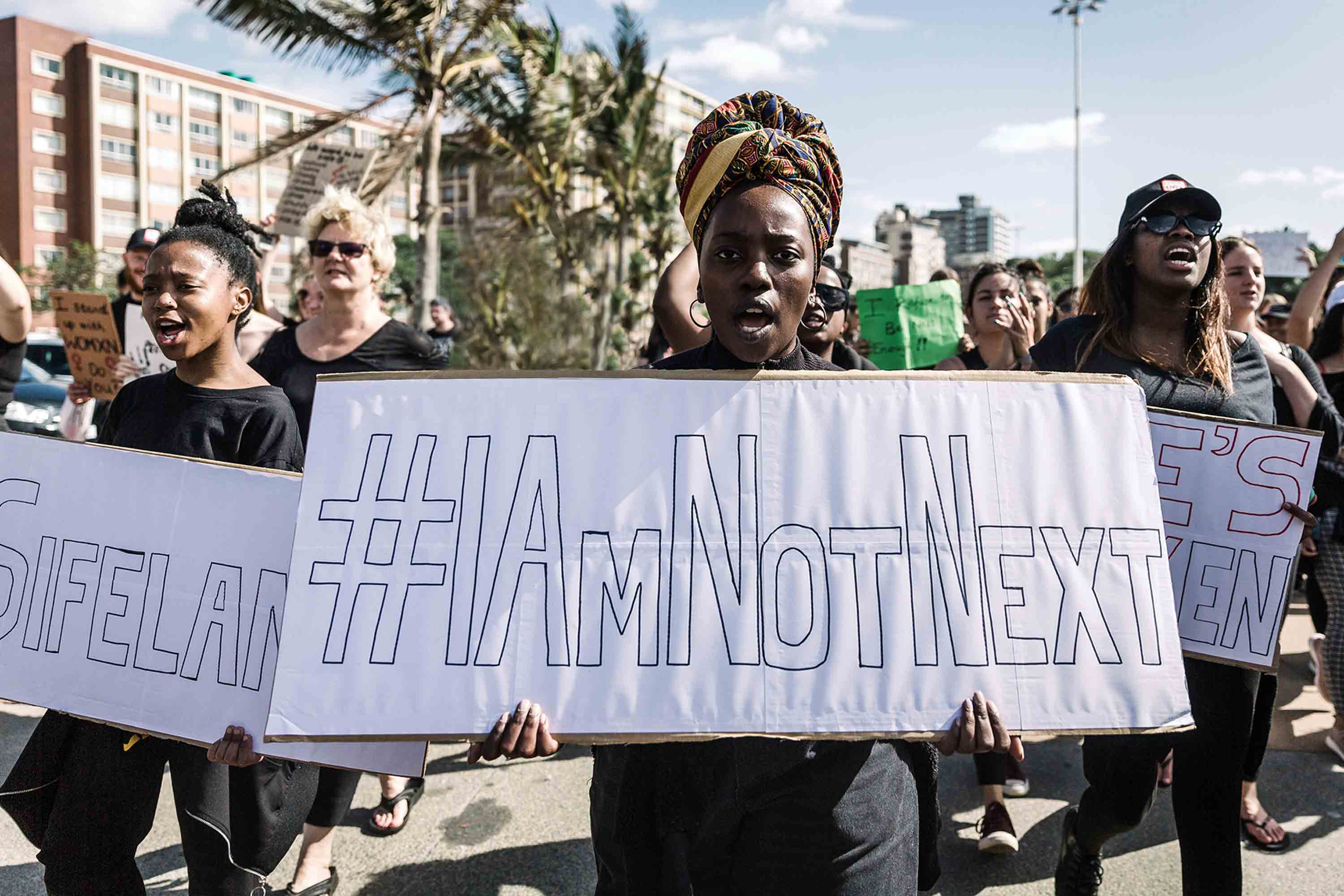 Getty
GettyIt has been estimated that a woman is killed in South Africa every four hours, but advocates for ending gender-based violence are committed to the fight ahead. “I think there’s a positive understanding again that there is a way out,” said Nomgqibelo Mdlalose, a technical advisor with the government’s Department of Women, Youth and Persons with Disabilities. “You look at social media, you talk to people: Everyone is like, ‘We will defeat this enemy.’”
In November 2022, Ramaphosa convened his second presidential summit to end gender-based violence. After he shared some dispiriting statistics—including how murders of women in South Africa have jumped 50% in the last year—delegates presented a new list of proposed solutions they’d fund with the overdue resources from the treasury, including expanding shelters for members of the LGBTQ+ community and funding legal outreach organizations for women, girls, and nonbinary violence survivors. They also expressed their plans to support a new educational curriculum in elementary schools that would dispel pervasive stereotypes about men’s superiority over women and promote bodily autonomy, and community outreach initiatives that would foster conversations with men about the toxicity of the patriarchy.
“We have got to actively empower from an early age, create a new socialization and unlearning of things that we have come to accept as normal, and men have got to take responsibility for driving the discourse,” said Dlamini. “Men must be part of the conversation in order to become part of the solution.”
At the summit, the national funding seemed to, at last, be within reach: Officials pledged that the council would finally be established by the spring of 2023, with the government money to be released shortly thereafter. This placated some attendees yet concerned others: For months, Ramaphosa has been chased by rumors that he will not be reelected by his party, the African National Congress. Now that he is rumored to be facing impeachment for financial cover-up, many advocates feel that his promises at the summit feel more conditional than if another term were certain for him.
But this does not alarm everyone. Mthembu, who co-organized the second presidential summit, said the progress Ramaphosa pledged would not necessarily leave the government with him. “With politicians, it’s a yin and yang. He might come back, he might not,” said Mthembu, who is currently a director in Ramaphosa’s private office dedicated to ending gender-based violence (which Ford funds). “Gender-based violence is in the presidential office now, and we can keep it there no matter who comes in. It can be prioritized by whoever is sitting in that seat.”
Nomgqibelo Mdlalose, a technical advisor with the government’s Department of Women, Youth and Persons with Disabilities, said last month’s summit was a success because it reignited her zeal to end gender-based violence—and she wasn’t alone. “We are not where we’re supposed to be yet, but the summit raised the urgency. Now there’s renewed commitment to find better ways to work together across government, private sector, and civil society,” she said. “I think there’s a positive understanding again that there is a way out. You look at social media, you talk to people: Everyone is like, ‘We will defeat this enemy.’”
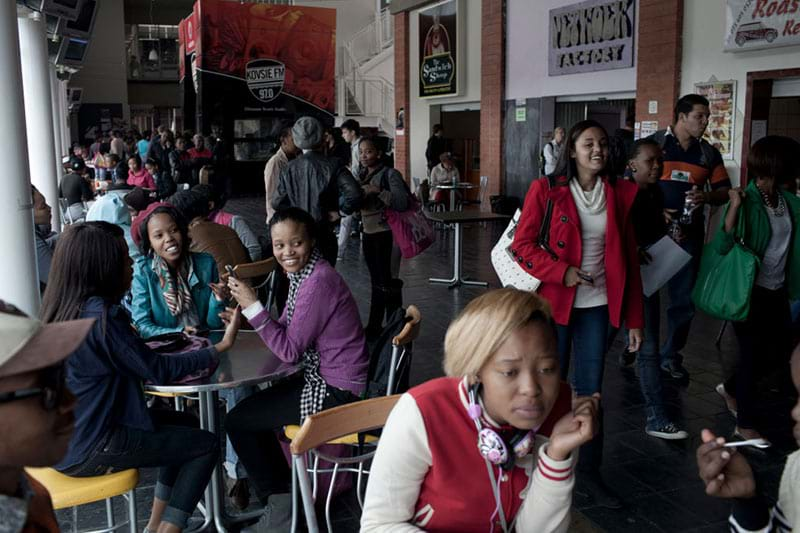 Getty
Getty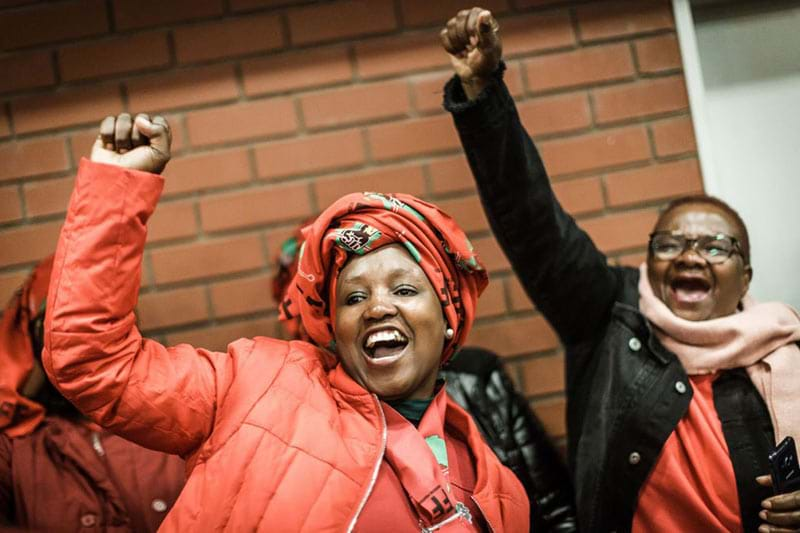 Getty
GettyWith continued efforts to end gender-based violence across the country, a brighter and safer future is possible for future generations. “Hope springs eternal,” said Lindi Dlamini, CEO of the Gender-Based Violence and Femicide Response Fund. “South Africa wouldn’t be where it is if, for instance, during the apartheid era, we’d just caved in and said, ‘Well, it is what it is. It’s too difficult to change.’”
Dlamini believes that #TheTotalShutdown movement and the government’s response offers a lesson to other social justice organizers in countries like Iran, Mexico, and Sudan who are currently staging their own efforts against gender-based violence.
“I think what we’ve shown is that we can never afford to cede our rights as citizens, even to constitutionally appointed representatives,” she said. “You can’t vote them into power and just carry on with your lives, which is what we did in a post-democratic South Africa. By the time we woke up to say, ‘What’s going on?’ we were in too deep.
“Hope springs eternal. South Africa wouldn’t be where it is if, for instance, during the apartheid era, we’d just caved in and said, ‘Well, it is what it is. It’s too difficult to change.’ We know how to keep the pressure on relentlessly.”
But how are spirits among #TheTotalShutdown’s organizers that started it all, the firebrand women who turned Facebook posts into South Africa’s largest-ever demonstration of women? They’re tired of the governmental morass, itching for progress as tangible and immediate as what they created—but they won’t let anything stop the momentum they began.
Candice Ludick was blunt. “If we look at our scorecard in terms of implementation, there’s definitely room for improvement. Let’s not joke: We’re halfway towards our five-year outcomes and, with some of them, it doesn’t seem like we’ve done anything. We need money to succeed, sure, but we also need more of the national strategic plan to be institutionalized,” she said. “It was a magic moment that got us to this point. But we’ve got to remain constantly vigilant.”
But within this vigilance, there exists plenty of opportunity, said Khanyile. “I believe in this national strategic plan. We need to do the education work now. People haven’t done the work of internalizing and understanding what this plan means. We need to go back to the people we mobilized during the march and say, ‘This is what you guys marched for. Let’s make sure it still happens.’”
Whatever the future holds in the fight against gender-based violence, and whichever leaders join the charge, Khanyile and her peers will never stop working to make their country safer for all women, girls, and gender-nonconforming people. In their hands, a brighter future for South Africa seems certain.
